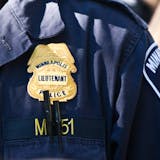A leading use of force expert with one of the nation's largest urban police departments testified Tuesday in Derek Chauvin's murder trial that the evidence from George Floyd's arrest late last spring showed him there were numerous clear signs that the now-fired Minneapolis officer should have eased up on his use of force.
Los Angeles Police Sgt. Jody Stiger's conclusions followed testimony earlier Tuesday from two Minneapolis police officers with experience in crisis intervention and use of force about proper procedures during the seventh day of testimony in Hennepin County District Court, with one of them saying that Chauvin's knee on Floyd's neck was not part of department training.
Stiger, a member of a police force with roughly 9,000 sworn officers, was hired by the prosecution to review relevant video from the scene, court records and training and policy material in preparation for his testimony.
Asked to sum up his analysis of what he learned about Floyd's arrest, Stiger said, "My opinion is that the force was excessive."
"Initially, when Mr. Floyd was being placed in the back seat of the vehicle, the officers were justified in trying to have him comply and sit in the back seat of the vehicle," the sergeant said. "However, once he was placed in the prone position on the ground, he slowly ceased his resistance and the officers — or ex-officers, I should say — should have slowed down or stopped their force."
Besides Floyd backing off his resistance, Stiger said other factors the officers should have considered when weighing use of force includes the nature of the original alleged offense, in Floyd's case the passing of a counterfeit $20 bill at Cup Foods at 38th and Chicago on May 25.
"Typically, in a normal situation" for what the sergeant said called low-level offense, "you wouldn't expect to use any force."
Stiger also said he could hear on one of the videos Floyd say "thank you" to the officers once they got him out of the squad and on his knees while still handcuffed behind his back.


